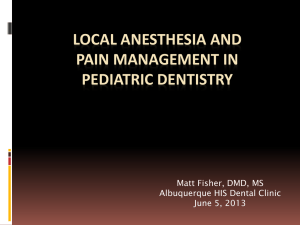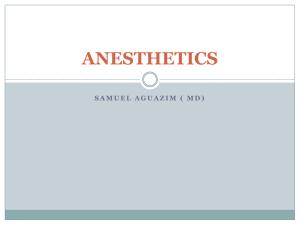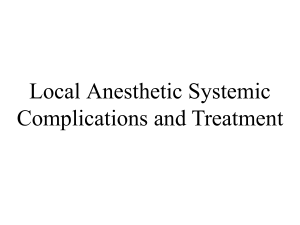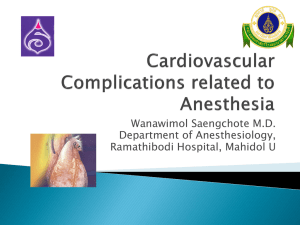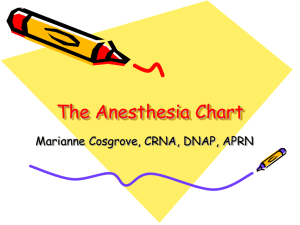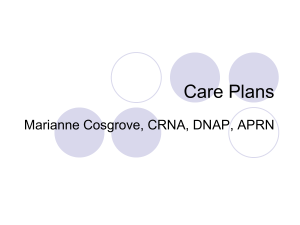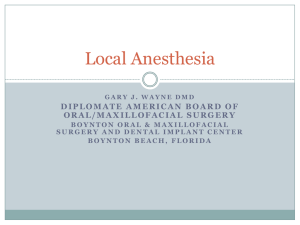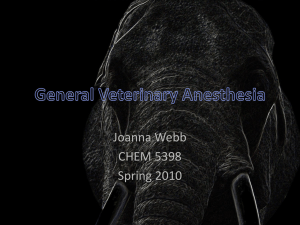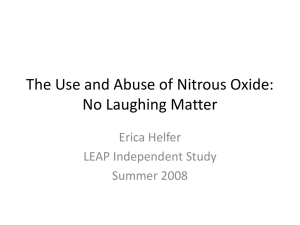Preanesthetic Patient Assessment
advertisement
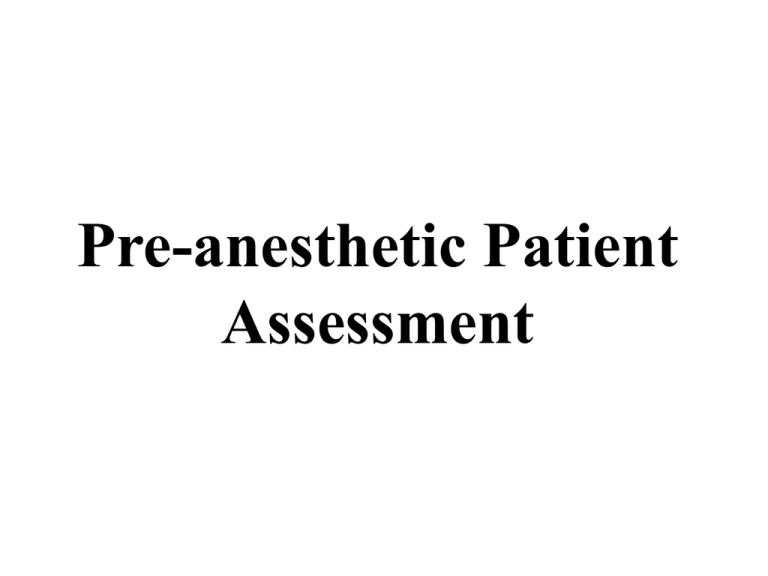
Pre-anesthetic Patient Assessment Thorough Review of Medical History • It is very important to evaluate the patient’s ability to tolerate local anesthetics and/or vasoconstrictors, allergic responses, and current medications • To determine if contraindications or modifications to treatment are needed • Help to prevent or minimize complications and emergencies Contraindications to LAs and Vasoconstrictors • Absolute contraindications – the drug should not be administered under any circumstances • Relative contraindications – the drug should be avoided; if a substitute is not available, a minimal dose of the drug may be used Hyperthyroidism • Exaggerated response to vasoconstrictor • Absolute contraindication of vasoconstrictor use in an uncontrolled hyperthyroid case • Limited use of vasoconstrictors indicated with surgically corrected or medicated-controlled hyperthyroid conditions Atypical Plasma Cholinesterase • 1 out of every 2,820 persons • Not always clinically significant symptoms • Usually found when patient is under general anesthesia • Missing enzyme that breaks down esters in the blood (plasma) • Relative contraindication to esters • Use amide anesthetics when possible Methemoglobinemia • Congenital or acquired condition • Hemoglobin is converted to methemoglobin which has less oxygen carrying capacity (potential of cyanosis) • Respiratory distress (prilocaine or articaine) • Relative contraindication to prilocaine and articaine, minimize dose if it must be used • Use other anesthetics if available Malignant Hyperthermia • Malignant Hyperthermia (MH) is an inherited disorder in which affected individuals do not react appropriately to certain general anesthesia drugs such as halothane, cyclopropane, and the muscle relaxant succinylcholine. This disorder is characterized by the development of a sudden and rapid high fever, muscle rigidity, and an irregular heartbeat (cardiac arrhythmia), after the administration of general anesthesia or certain muscle relaxants. Malignant Hyperthermia • One of the most life-threatening complications associated with the administration of general anesthesia • Relative contraindication to use of amides • Consult with physician is strongly recommended Liver Dysfunction • Difficulty metabolizing amides, potential for overdose in significant liver dysfunction • Relative contraindication to amides • Use amides at minimal doses • Consult with physician Renal Dysfunction • Excretion of local anesthetic is difficult with significant renal dysfunction, potential for overdose • Use anesthetic agents in minimal doses • Consult with physician Pregnancy • May have complications • Relative contraindication to elective treatment during the first trimester • Use local anesthetics at minimal doses • Anesthetics and vasoconstrictors do cross the placenta, but are not teratogens High Blood Pressure • OK to administer anesthesia with vasoconstrictor judiciously • Take patient’s blood pressure prior to the injection • Monitor patient’s blood pressure Prosthetic Heart Valve, Heart Transplant • Local anesthesia does not require antibiotic prophylaxis (pre-med) with the exception of the PDL injection, but the patient more than likely will be premedicated for the dental treatment requiring the anesthetizing Patient Medications • Have the patient complete a thorough medical history • Question the patient regarding yes responses to questions • Look up all medications in a drug reference text for any contraindications • Local anesthetics have few interactions with other prescribed drugs Patient Medications Vasoconstrictors may interact with: • Tricyclic antidepressants (Elavil) • Phenothiazines (antipsychotic drugs) • Beta-receptor blockers (propranolol)increase blood pressure • Adrenergic neuron blockers- increase BP • Use minimal dose or use anesthetic without vasoconstrictor Sulfa Drugs • Esters inhibit the bacteriostatic action of sulfonamides • Do not use esters (procaine, tetracaine) • Use amide anesthetics • Sulfa drugs and ester anesthetics are used rarely today, so this drug interaction is unlikely Cimetidine (Tagamet) • Modifies the biotransformation of lidocaine in the liver • Little clinical significance unless the patient has congestive heart failure (CHF) • Relative contraindication to the use of amide local anesthetics - minimal doses should be used Allergy • An allergy is a hypersensitive reaction acquired through exposure to a specific substance (allergen); re-exposure to the allergen increases one’s potential to react. • Note previous local anesthesia “allergies” documented on patient medical history • Only 1% of all reactions during administration of local anesthetics are true allergic reactions • Rare with amides • Based on allergy, may elect to use alternative anesthesia Sulfite Allergy • Sodium bisulfite or metasulfite • Bisulfites are antioxidants which are commonly sprayed on fruits and vegetables to keep them appearing fresh • Often associated with asthmatics • Use a plain anesthetic since sodium bisulfite is used to preserve the vasoconstrictor in anesthetic solutions Preanesthetic Patient Assessment Quiz 1. An absolute contraindication to using a local anesthetic means: a. The anesthetic can be used with the maximum recommended dose b. The anesthetic can be used in minimal doses c. The anesthetic should not be used under any circumstances d. The anesthetic can be used without a vasoconstrictor 2. A relative contraindication to using a local anesthetic means: a. The anesthetic can be used with the maximum recommended dose b. The anesthetic can be used in minimal doses c. The anesthetic should not be used under any circumstances d. The anesthetic should be used without a vasoconstrictor 3. Your patient has uncontrolled hyperthyroidism. What is the indication for local anesthesia use? a. The use of local anesthetic is an absolute contraindication b. The use of local anesthetic with a vasoconstrictor is an absolute contraindication c. The use of local anesthetic is a relative contraindication d. The use of local anesthetic with a vasoconstrictor is a relative contraindication 4. What anesthetic(s) is/are contraindicated for a person with methemoglobinemia? a. Articaine b. Lidocaine c. Prilocaine d. a and b e. a and c 5. Which of the following is/are true about malignant hyperthermia? a. One of the most life threatening complications of general anesthesia b. A relative contraindication to amides exists c. No contraindication to esters exists d. Consultation with physician is strongly recommended e. All of the above 6. Your patient has a liver dysfunction. Which of the following is NOT true? a. There is a relative contraindication to amides b. There is an absolute contraindication to amides c. You can use amides in minimal doses d. Consultation with physician is recommended 7. Esters counteract the bacteriostatic action of sulfa drugs. Esters and sulfa drugs are rarely used today, so this drug interaction is highly unlikely. a. The first part of the statement is true, the second part is true. b. The first part of the statement is true, the second part is false. c. The first part of the statement is false, part of the statement is true. d. The first part of the statement is false, the second part is false. 8. Cimetidine (Tagamet) modifies the biotransformation of __________ in the liver, therefore a patient taking Tagamet should not receive this anesthetic. a. Articaine b. Lidocaine c. Mepivacaine d. Prilocaine 9. What is atypical plasma cholinesterase? a. A liver dysfunction b. The blood is missing the enzyme that breaks down amides c. The blood is missing the enzyme that breaks down esters d. The blood will not form a clot 10. Your patient has a sulfite allergy. What anesthetic should you choose to use on this patient? a. An anesthetic without a vasoconstrictor b. An anesthetic with a vasoconstrictor c. An ester d. An amide
